Building Façade Retrofit with Solar Passive Technologies: A Literature Review
Abstract
:1. Introduction
2. Solar Availability
3. Solar Passive Technologies
3.1. Glazing Technologies
- Installing a secondary window in addition to the existing single-glazed window;
- Replacing the entire window system;
- Adding Solar Control Films (SCFs) to the existing window.
3.2. Sun Shading Technologies
3.3. Sunspace Technologies
3.4. Trombe Wall Technologies
| Solar Passive Technology | Location | Type of Study | Type of Building | Energy Analysis | General Findings: Benefits | General Findings: Drawbacks and Recommendations | Ref. |
|---|---|---|---|---|---|---|---|
| Glazing technologies | Multiple locations, including Portugal (Almada) | Numerical | Residential |
|
|
| [52] |
| Portugal (Lisbon) | Experimental and numerical | Office |
|
|
| [59] | |
| Sun shading technologies | Portugal (Lisbon) | Numerical | Residential |
|
|
| [38] |
| Multiple locations, including Portugal (Porto) | Numerical | Residential |
|
|
| [70] | |
| Multiple locations, including Portugal (Lisbon) | Numerical | Residential |
|
|
| [71] | |
| Sunspace technologies | Portugal (Porto) | Experimental and numerical | Residential |
|
|
| [79] |
| Portugal (multiple locations on the mainland) | Numerical | Residential |
|
|
| [80] | |
| Trombe wall | Portugal (Vila Real) | Experimental and numerical | Test cell |
|
|
| [84,85,88] |
| Portugal (Caparica) | Experimental | Test cell |
|
|
| [94] | |
| Portugal (Lisbon, Porto, Lajes, Funchal) | Numerical | Test cell |
|
|
| [90] |
4. Feasibility of Retrofit Works with Solar Passive Technologies
- Retrofit conditions—questions such as the disturbance levels to the inhabitants or site and the possibility of working from the inside of the building vs. the need for scaffoldings in high-rise buildings should be holistically weighed, as shown in [97].
- Compatibility between the existing constructive solutions and the proposing retrofit technologies—the retrofit design project should be compatible with the existing solution (e.g., materials properties), and possible consequences should be assessed (e.g., reduction of air permeability and the creation of new thermal bridge areas following the fixation of new constructive systems), as well as how to mitigate them [98];
- Impact on cultural heritage—the retrofit design project should involve a strong dichotomy between aesthetic–architectonical value and energy efficiency goals, especially in the context of the rehabilitation of historic buildings [99].
5. Conclusions
- Direct solar technologies (glazing and sun shading) are commonly used strategies to thermally retrofit Portuguese façades, and they are often applied together. Their widespread application is assisted by: (a) their simplicity (easy elements to retrofit); (b) the Portuguese regulation that presents design parameters (which facilitates the job of building designers); (c) national financial support programs (incentives). Sun shading is often recommended in the literature, but its specific impact is usually not indicated.
- There is an apparent scarcity of studies on indirect solar technologies used to retrofit Portuguese buildings. Regarding sunspaces, even though balconies are often converted into sunspaces, there are no sufficient available data on the optimization design parameters leading to the upgrade of the energy performance. Regarding Trombe wall systems, most of the studies found were devised in the last decade, meaning that there is a growing interest in this subject. All in all, more detailed studies and research (on optimization design, operation, and efficiency) should be devised on Trombe wall systems to encourage building designers and owners to consider this technology.
- Studies have shown that solar passive technologies usually lead to energy savings. However, more detailed feasibility studies should be conducted, especially concerning cost and environmental indicators. Specific studies on the feasibility of solar passive technologies compared to conventional retrofit solutions should also be conducted to further increase the knowledge on solar passive technologies in the Portuguese context.
- Overall, it was concluded that building retrofit with solar passive technologies may be a viable way to (a) improve the thermal comfort and efficiency (more energy savings and lower greenhouse gas emissions) of buildings in the Mediterranean climate context, (b) further improve the technical and scientific knowledge, (c) increase the building value as it updates it toward current living standards and (d) contribute toward achieving greener buildings and cities.
Author Contributions
Funding
Institutional Review Board Statement
Informed Consent Statement
Data Availability Statement
Conflicts of Interest
References
- Manzano-Agugliaro, F.; Montoya, F.G.; Sabio-Ortega, A.; García-Cruz, A. Review of bioclimatic architecture strategies for achieving thermal comfort. Renew. Sustain. Energy Rev. 2015, 49, 736–755. [Google Scholar]
- Santamouris, M.; Pavlou, K.; Synnefa, A.; Niachou, K.; Kolokotsa, D. Recent progress on passive cooling techniques. Advanced technological developments to improve survivability levels in low-income households. Energy Build. 2007, 39, 859–866. [Google Scholar]
- EU. Directive 2002/91/EC of the European parliment and the council of of 16 December 2002 on the energy performance of buildings. Off. J. Eur. Union 2002, 46, 65–71. [Google Scholar]
- EU. Directive 2010/31/EU of the European Parliament and of the Council of 19 May 2010 on the energy performance of buildings (recast). Off. J. Eur. Union 2010, 53, 13–35. [Google Scholar]
- EU. Directive of the European Parliament and of the Council on the energy performance of buildings (recast). Off. J. Eur. Union 2018, 61, 82–205. [Google Scholar]
- Suárez, R.; Fernández-Agüera, J. Retrofitting of Energy Habitability in Social Housing: A Case Study in a Mediterranean Climate. Buildings 2011, 1, 4–15. [Google Scholar]
- Asadi, E.; da Silva, M.G.; Antunes, C.H.; Dias, L.; Glicksman, L. Multi-objective optimization for building retrofit: A model using genetic algorithm and artificial neural network and an application. Energy Build. 2014, 81, 444–456. [Google Scholar]
- Statistics Portugal-INE. Censos 2011 Resultados Definitivos. Available online: https://censos.ine.pt/ngt_server/attachfileu.jsp?look_parentBoui=148313382&att_display=n&att_download=y (accessed on 2 February 2021).
- Diário da República. Decreto-Lei n.o 40/90, de 6 de Fevereiro—Aprovação do Regulamento das Características de Comportamento Térmico dos Edifcícios. D. Repúb. 1990, 40, 490–504. [Google Scholar]
- Abreu, M.I.; Oliveira, R. O contexto atual da reabilitação energética do parque edificado em Portugal. Congr. Construção 2012, 1–12. [Google Scholar]
- Magalhães, S.M.C.; Leal, V.M.S. Characterization of thermal performance and nominal heating gap of the residential building stock using the EPBD-derived databases: The case of Portugal mainland. Energy Build. 2014, 70, 167–179. [Google Scholar]
- Stazi, F.; Bonfigli, C.; Tomassoni, E.; Di Perna, C.; Munafò, P. The effect of high thermal insulation on high thermal mass: Is the dynamic behaviour of traditional envelopes in Mediterranean climates still possible? Energy Build. 2015, 88, 367–383. [Google Scholar]
- Alizadeh, M.; Sadrameli, S. Development of free cooling based ventilation technology for buildings: Thermal energy storage (TES) unit, performance enhancement techniques and design considerations—A review. Renew. Sustain. Energy Rev. 2016, 58, 619–645. [Google Scholar]
- Ascione, F.; Bianco, N.; Rossi, F.D.; Turni, G.; Vanoli, G.P. Different methods for the modelling of thermal bridges into energy simulation programs: Comparisons of accuracy for flat heterogeneous roofs in Italian climates. Appl. Energy 2012, 97, 405–418. [Google Scholar]
- Escandón, R.; Suárez, R.; Sendra, J.J.; Ascione, F.; Bianco, N.; Mauro, G.M. Predicting the Impact of Climate Change on Thermal Comfort in A Building Category: The Case of Linear-type Social Housing Stock in Southern Spain. Energies 2019, 12, 2238. [Google Scholar]
- Filippi, M. Remarks on the green retrofitting of historic buildings in Italy. Energy Build. 2015, 95, 15–22. [Google Scholar]
- Boeri, A.; Gabrielli, L.; Longo, D. Evaluation and Feasibility Study of Retrofitting Interventions on Social Housing in Italy. Procedia Eng. 2011, 21, 1161–1168. [Google Scholar]
- Kottek, M.; Grieser, J.; Beck, C.; Rudolf, B.; Rubel, F. World Map of the Köppen-Geiger climate classification updated. Meteorol. Z. 2006, 15, 259–263. [Google Scholar]
- Diário da Républica. Decreto-Lei n.o. 118/2013, de 20 de Agosto—Aprovação do Sistema de Certificação Energética dos Edifícios, do Regulamento de Desempenho Energético dos Edifícios de Habitação e do Regulamento de Desempenho Energético dos Edifícios de Comércio e Serviços. D. Repúb. 2013, 118, 4988–5005. [Google Scholar]
- Garde, F.; Aelenei, D.; Aelenei, L.; Scognamiglio, A.; Ayoub, J. Solution Sets for Net-Zero Energy Buildings; John Wiley & Sons: Hoboken, NJ, USA, 2017. [Google Scholar]
- Stevanović, S. Optimization of passive solar design strategies: A review. Renew. Sustain. Energy Rev. 2013, 25, 177–196. [Google Scholar]
- Souayfane, F.; Biwolé, P.H.; Fardoun, F. Thermal behavior of a translucent superinsulated latent heat energy storage wall in summertime. Appl. Energy 2018, 217, 390–408. [Google Scholar]
- Ruiz, Á.; Salmerón, J.M.; Sánchez, F.; González, R.; Álvarez, S. A calculation model for Trombe walls and its use as a passive cooling technique. In Proceedings of the International Conference on Passiveand Low Energy Cooling for the Built Environment, Heliotopos Conferences, Santorini, Greece, 19–21 May 2005; pp. 365–369. [Google Scholar]
- Rodrigues, A.M.; Santos, M.; Gomes, M.G.; Duarte, R. Impact of Natural Ventilation on the Thermal and Energy Performance of Buildings in a Mediterranean Climate. Buildings 2019, 9, 123. [Google Scholar]
- Martínez-Molina, A.; Tort-Ausina, I.; Cho, S.; Vivancos, J.-L. Energy efficiency and thermal comfort in historic buildings: A review. Renew. Sustain. Energy Rev. 2016, 61, 70–85. [Google Scholar]
- Cuce, E.; Riffat, S.B. A state-of-the-art review on innovative glazing technologies. Renew. Sustain. Energy Rev. 2015, 41, 695–714. [Google Scholar]
- Kirimtat, A.; Koyunbaba, B.K.; Chatzikonstantinou, I.; Sariyildiz, S. Review of simulation modeling for shading devices in buildings. Renew. Sustain. Energy Rev. 2016, 53, 23–49. [Google Scholar]
- Bellia, L.; Marino, C.; Minichiello, F.; Pedace, A. An Overview on Solar Shading Systems for Buildings. Energy Procedia 2014, 62, 309–317. [Google Scholar]
- Saadatian, O.; Sopian, K.; Lim, C.; Asim, N.; Sulaiman, M. Trombe walls: A review of opportunities and challenges in research and development. Renew. Sustain. Energy Rev. 2012, 16, 6340–6351. [Google Scholar]
- Hu, Z.; He, W.; Ji, J.; Zhang, S. A review on the application of Trombe wall system in buildings. Renew. Sustain. Energy Rev. 2017, 70, 976–987. [Google Scholar]
- Compagnon, R. Solar and daylight availability in the urban fabric. Energy Build. 2004, 36, 321–328. [Google Scholar]
- Chatzipoulka, C.; Compagnon, R.; Kaempf, J.; Nikolopoulou, M. Sky view factor as predictor of solar availability on building façades. Sol. Energy 2018, 170, 1026–1038. [Google Scholar]
- Stazi, F.; Mastrucci, A.; di Perna, C. The behaviour of solar walls in residential buildings with different insulation levels: An experimental and numerical study. Energy Build. 2012, 47, 217–229. [Google Scholar]
- Koyunbaba, B.K.; Yilmaz, Z. The comparison of Trombe wall systems with single glass, double glass and PV panels. Renew. Energy 2012, 45, 111–118. [Google Scholar]
- Brito, M.; Freitas, S.; Guimarães, S.; Catita, C.; Redweik, P. The importance of facades for the solar PV potential of a Mediterranean city using LiDAR data. Renew. Energy 2017, 111, 85–94. [Google Scholar]
- European Comission. PV GIS. Available online: https://re.jrc.ec.europa.eu/pvg_tools/en/#MR (accessed on 31 January 2021).
- Mendonça, P. Habitar sob Uma Segunda Pele: Estratégias para a Redução do Impacto Ambiental de Construções Solares Passivas em Climas Temperados; Universidade do Minho: Braga, Portugal, 2005. [Google Scholar]
- Tavares, M.C.P.; Gonçalves, H.J.P.; Bastos, J.N.T.D.F.C. The glazing area in residential buildings in temperate climate: The thermal-energetic performance of housing units in Lisbon. Energy Build. 2017, 140, 280–294. [Google Scholar]
- Ministério da Economia e Inovação. Plano Nacional de Acção para a Eficiência Energética (PNAEE) 2015. 2008.
- Smith, N.; Isaacs, N.; Burgess, J.; Cox-Smith, I. Thermal performance of secondary glazing as a retrofit alternative for single-glazed windows. Energy Build. 2012, 54, 47–51. [Google Scholar]
- Santos, H.; Valença, P.; Fernandes, E.O. UNESCO’s Historic Centre of Porto: Rehabilitation and Sustainability. Energy Procedia 2017, 133, 86–94. [Google Scholar]
- Rodrigues, F.; Parada, M.; Vicente, R.; Oliveira, R.; Alves, A.; Rodrigues, M.F. High Energy Efficiency Retrofits in Portugal. Energy Procedia 2015, 83, 187–196. [Google Scholar]
- Bastos, J.; Batterman, S.A.; Freire, F. Life-cycle energy and greenhouse gas analysis of three building types in a residential area in Lisbon. Energy Build. 2014, 69, 344–353. [Google Scholar]
- Rodrigues, C.; Freire, F. Integrated life-cycle assessment and thermal dynamic simulation of alternative scenarios for the roof retrofit of a house. Build. Environ. 2014, 81, 204–215. [Google Scholar]
- Alves, S.; Sendra, J.J. Evaluating constructive and typological retrofits in solid masonry historic buildings. In Structural Studies, Repairs and Maintenance of Heritage Architecture XIV; Brebbia, C.A., Hernández, S., Eds.; WIT Press: Southampton, UK, 2015; pp. 381–391. [Google Scholar]
- Rodrigues, C.; Freire, F. Building retrofit addressing occupancy: An integrated cost and environmental life-cycle analysis. Energy Build. 2017, 140, 388–398. [Google Scholar]
- Eskander, M.M.; Sandoval-Reyes, M.; Silva, C.A.; Vieira, S.; Sousa, J.M. Assessment of energy efficiency measures using multi-objective optimization in Portuguese households. Sustain. Cities Soc. 2017, 35, 764–773. [Google Scholar]
- Rodrigues, C.; Freire, F. Adaptive reuse of buildings: Eco-efficiency assessment of retrofit strategies for alternative uses of an historic building. J. Clean. Prod. 2017, 157, 94–105. [Google Scholar]
- Monteiro, C.S.; Causone, F.; Cunha, S.; Pina, A.; Erba, S. Addressing the challenges of public housing retrofits. Energy Procedia 2017, 134, 442–451. [Google Scholar]
- Carlos, J.S.; Corvacho, H. Retrofit Measures in Old Elementary School Buildings Towards Energy Efficiency. J. Civ. Eng. Manag. 2010, 16, 567–576. [Google Scholar]
- Brás, A.; Rocha, A.; Faustino, P. Integrated approach for school buildings rehabilitation in a Portuguese city and analysis of suitable third party financing solutions in EU. J. Build. Eng. 2015, 3, 79–93. [Google Scholar]
- Eicker, U.; Demir, E.; Gürlich, D. Strategies for cost efficient refurbishment and solar energy integration in European Case Study buildings. Energy Build. 2015, 102, 237–249. [Google Scholar]
- Diário da Républica. Decreto-Lei n.o. 79/2006, de 4 de Abril—Aprovação do Regulamento dos Sistemas Energéticos de Climatização em Edifícios (RSECE). D. Repúb. 2006, 76, 2411–2415. [Google Scholar]
- Panão, M.J.O. Revisiting cooling energy requirements of residential buildings in Portugal in light of climate change. Energy Build. 2014, 76, 354–362. [Google Scholar]
- Sacht, H.; Bragança, L.; Almeida, M.; Nascimento, J.H.; Caram, R. Spectrophotometric Characterization of Simple Glazings for a Modular Façade. Energy Procedia 2016, 96, 965–972. [Google Scholar]
- Moretti, E.; Belloni, E. Evaluation of energy, thermal, and daylighting performance of solar control films for a case study in moderate climate. Build. Environ. 2015, 94, 183–195. [Google Scholar]
- Pereira, J.; Gomes, M.G.; Rodrigues, A.M.; Teixeira, H.; Almeida, M. Small-scale field study of window films’ impact on daylight availability under clear sky conditions. J. Façade Des. Eng. 2020, 8, 73–84. [Google Scholar]
- Pereira, J.; Gomes, M.G.; Rodrigues, A.M.; Almeida, M. Thermal, luminous and energy performance of solar control films in single-glazed windows: Use of energy performance criteria to support decision making. Energy Build. 2019, 198, 431–443. [Google Scholar]
- Teixeira, H.; Gomes, M.G.; Rodrigues, A.M.; Pereira, J. Thermal and visual comfort, energy use and environmental performance of glazing systems with solar control films. Build. Environ. 2020, 168, 106474. [Google Scholar]
- Causone, F.; Corgnati, S.P.; Filippi, M.; Olesen, B.W. Solar radiation and cooling load calculation for radiant systems: Definition and evaluation of the Direct Solar Load. Energy Build. 2010, 42, 305–314. [Google Scholar]
- Alcoforado, M.J.; Lopes, A.; Andrade, H.; Vasconcelos, J. Orientações Climáticas para o Ordenamento em Lisboa; Centro de Estudos Geográficos da Universidade de Lisboa (CEG UL): Lisbon, Portugal, 2005. [Google Scholar]
- Ferreira, J.; Pinheiro, M.D. In search of better energy performance in the Portuguese buildings—The case of the Portuguese regulation. Energy Policy 2011, 39, 7666–7683. [Google Scholar]
- Barbosa, R.; Vicente, R.; Santos, R. Climate change and thermal comfort in Southern Europe housing: A case study from Lisbon. Build. Environ. 2015, 92, 440–451. [Google Scholar]
- Monzón-Chavarrías, M.; López-Mesa, B.; Resende, J.; Corvacho, H. The nZEB concept and its requirements for residential buildings renovation in Southern Europe: The case of multi-family buildings from 1961 to 1980 in Portugal and Spain. J. Build. Eng. 2021, 34, 101918. [Google Scholar]
- Mingfang, T. Solar control for buildings. Build. Environ. 2002, 37, 659–664. [Google Scholar]
- Gomes, M.G.; Santos, A.; Rodrigues, A.M. Solar and visible optical properties of glazing systems with venetian blinds: Numerical, experimental and blind control study. Build. Environ. 2014, 71, 47–59. [Google Scholar]
- Gomes, M.D.G.; Rodrigues, A.M.; Bogas, J.A. Numerical and experimental study of the optical properties of venetian blinds. J. Build. Phys. 2012, 36, 7–34. [Google Scholar]
- Sousa, J.; Silva, S.; Almeida, M. Energy Rehabilitation of Portuguese Residential Building Stock Through its Transformation into NZEB. In Seminário Reabilitação Energética de Edifícios; Almeida, M., Bragança, L., Silva, P., Silva, S., Mateus, R., Barbosa, J., Araújo, C., Eds.; Univ. of Minho: Minho, Portugal, 2012; pp. 41–48. [Google Scholar]
- Ferreira, M.A.P.S.; De Almeida, M.G.; Rodrigues, A.C.R.A. Cost-optimal energy efficiency levels are the first step in achieving cost effective renovation in residential buildings with a nearly-zero energy target. Energy Build. 2016, 133, 724–737. [Google Scholar]
- Capeluto, I.G.; Ochoa, C.E. Simulation-based method to determine climatic energy strategies of an adaptable building retrofit façade system. Energy 2014, 76, 375–384. [Google Scholar]
- Palmero-Marrero, A.I.; Oliveira, A.C. Effect of louver shading devices on building energy requirements. Appl. Energy 2010, 87, 2040–2049. [Google Scholar]
- Kim, G.; Lim, H.S.; Lim, T.S.; Schaefer, L.; Kim, J.T. Comparative advantage of an exterior shading device in thermal performance for residential buildings. Energy Build. 2012, 46, 105–111. [Google Scholar]
- Tzempelikos, A.; Athienitis, A.K. The impact of shading design and control on building cooling and lighting demand. Sol. Energy 2007, 81, 369–382. [Google Scholar]
- Aelenei, L.; Pereira, R.; Gonçalves, H.; Athienitis, A.K. Thermal Performance of a Hybrid BIPV-PCM: Modeling, Design and Experimental Investigation. Energy Procedia 2014, 48, 474–483. [Google Scholar]
- Ulpiani, G.; Giuliani, D.; Romagnoli, A.; Di Perna, C. Experimental monitoring of a sunspace applied to a NZEB mock-up: Assessing and comparing the energy benefits of different configurations. Energy Build. 2017, 152, 194–215. [Google Scholar]
- Oliveti, G.; Arcuri, N.; De Simone, M.; Bruno, R. Solar heat gains and operative temperature in attached sunspaces. Renew. Energy 2012, 39, 241–249. [Google Scholar]
- Mihalakakou, G.K.; Ferrante, A. Energy conservation and potential of a sunspace: Sensitivity analysis. Energy Convers. Manag. 2000, 41, 1247–1264. [Google Scholar]
- Patrício, A.; Gonçalves, H.; Saraiva, J. The use of sunspaces in Portugal. PLEA’98 1998, 98, 361. [Google Scholar]
- Macieira, M.; Mendonça, P.; Guedes, J.M. Membrane Sunspace for Old Buildings Refurbishment: Environmental Impact, Economic and Building Technology’s Comparison to Conventional Solutions. In Proceedings of the MATEC Web of Conferences, Lisbon, Portugal, 26–28 September 2018; Volume 278, p. 04002. [Google Scholar]
- Aelenei, D.; Leal, H.D.A.; Aelenei, L. The Use of Attached-sunspaces in Retrofitting Design: The Case of Residential Buildings in Portugal. Energy Procedia 2014, 48, 1436–1441. [Google Scholar]
- Özdenefe, M.; Atikol, U.; Rezaei, M. Trombe wall size-determination based on economic and thermal comfort viability. Sol. Energy 2018, 174, 359–372. [Google Scholar]
- Hami, K.; Draoui, B.; Hami, O. The thermal performances of a solar wall. Energy 2012, 39, 11–16. [Google Scholar]
- Zhang, T.; Tan, Y.; Yang, H.; Zhang, X. The application of air layers in building envelopes: A review. Appl. Energy 2016, 165, 707–734. [Google Scholar]
- Sá, A.B.; Boaventura-Cunha, J.; Lanzinha, J.-C.; Paiva, A. An experimental analysis of the Trombe wall temperature fluctuations for high range climate conditions: Influence of ventilation openings and shading devices. Energy Build. 2017, 138, 546–558. [Google Scholar]
- Briga-Sá, A.; Martins, A.; Boaventura-Cunha, J.; Lanzinha, J.C.; Paiva, A. Energy performance of Trombe walls: Adaptation of ISO 13790:2008(E) to the Portuguese reality. Energy Build. 2014, 74, 111–119. [Google Scholar]
- Özbalta, T.; Kartal, S. Heat gain through Trombe wall using solar energy in a cold region of Turkey. Sci. Res. Essays 2010, 5, 2768–2778. [Google Scholar]
- Dabaieh, M.; Elbably, A. Ventilated Trombe wall as a passive solar heating and cooling retrofitting approach; a low-tech design for off-grid settlements in semi-arid climates. Sol. Energy 2015, 122, 820–833. [Google Scholar]
- Briga-Sá, A.; Boaventura-Cunha, J.; Lanzinha, J.-C.; Paiva, A. Experimental and analytical approach on the Trombe wall thermal performance parameters characterization. Energy Build. 2017, 150, 262–280. [Google Scholar]
- Stazi, F.; Mastrucci, A.; di Perna, C. Trombe wall management in summer conditions: An experimental study. Sol. Energy 2012, 86, 2839–2851. [Google Scholar]
- Sacht, H.M.; Bragança, L.; Almeida, M.; Caram, R. Trombe wall thermal performance for a modular façade system in different portuguese climates: Lisbon, Porto, Lajes and Funchal. In Proceedings of the 12th Conference of International Building Performance Simulation Association, Sydney, Australia, 14–16 November 2011; pp. 1444–1450. [Google Scholar]
- Stazi, F.; Mastrucci, A.; Munafò, P. Life cycle assessment approach for the optimization of sustainable building envelopes: An application on solar wall systems. Build. Environ. 2012, 58, 278–288. [Google Scholar]
- Bellos, E.; Tzivanidis, C.; Zisopoulou, E.; Mitsopoulos, G.; Antonopoulos, K.A. An innovative Trombe wall as a passive heating system for a building in Athens—A comparison with the conventional Trombe wall and the insulated wall. Energy Build. 2016, 133, 754–769. [Google Scholar]
- Soussi, M.; Balghouthi, M.; Guizani, A. Energy performance analysis of a solar-cooled building in Tunisia: Passive strategies impact and improvement techniques. Energy Build. 2013, 67, 374–386. [Google Scholar]
- Aelenei, D.; Brito-Coimbra, S.; Gomes, M.G.; Rodrigues, A.M. Solar Bridge Retrofit System: An innovative solution to renovate structural thermal bridge areas. Energy Build. 2021, 236, 110784. [Google Scholar]
- De Vasconcelos, A.B.; Pinheiro, M.D.; Manso, A.; Cabaço, A. EPBD cost-optimal methodology: Application to the thermal rehabilitation of the building envelope of a Portuguese residential reference building. Energy Build. 2016, 111, 12–25. [Google Scholar]
- Ferreira, J.M.S.; Pinheiro, M.D.; De Brito, J. Refurbishment decision support tools: A review from a Portuguese user’s perspective. Constr. Build. Mater. 2013, 49, 425–447. [Google Scholar]
- Vares, S. Sustainable Refurbishment of Exterior Walls and Building Facades; VTT: Espoo, Finland, 2012. [Google Scholar]
- Fernandes, D.; Santos, C.P.d.; Faria, P. A Realidade Da Reabilitação Em Portugal—Uma Abordagem Térmico-Energética. In Proceedings of the Congresso Internacional da Habitação no espaço Lusófuno, Lisboa, Portugal, 12–13 March 2013; pp. 1–13. [Google Scholar]
- Galatioto, A.; Ciulla, G.; Ricciu, R. An overview of energy retrofit actions feasibility on Italian historical buildings. Energy 2017, 137, 991–1000. [Google Scholar]
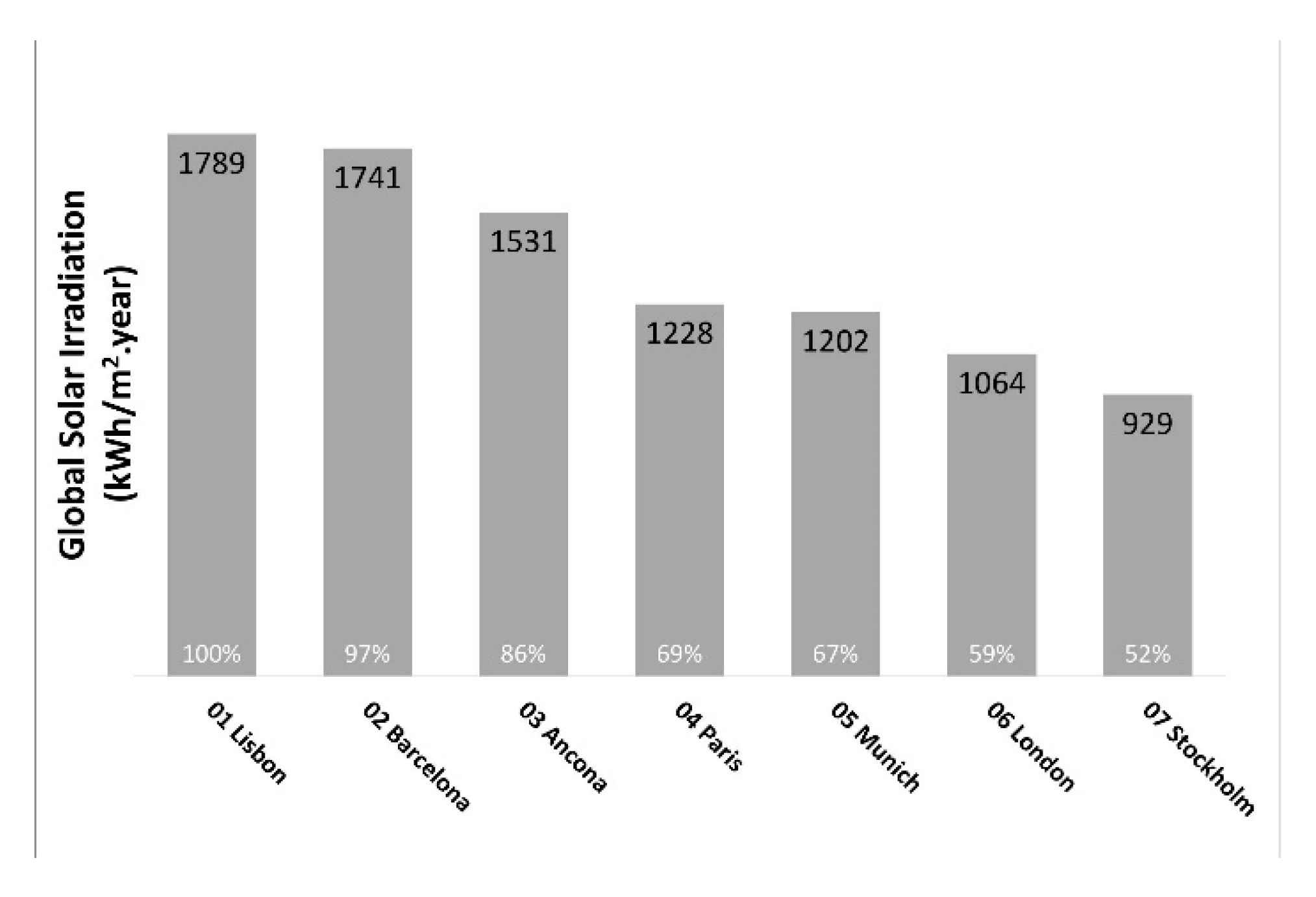
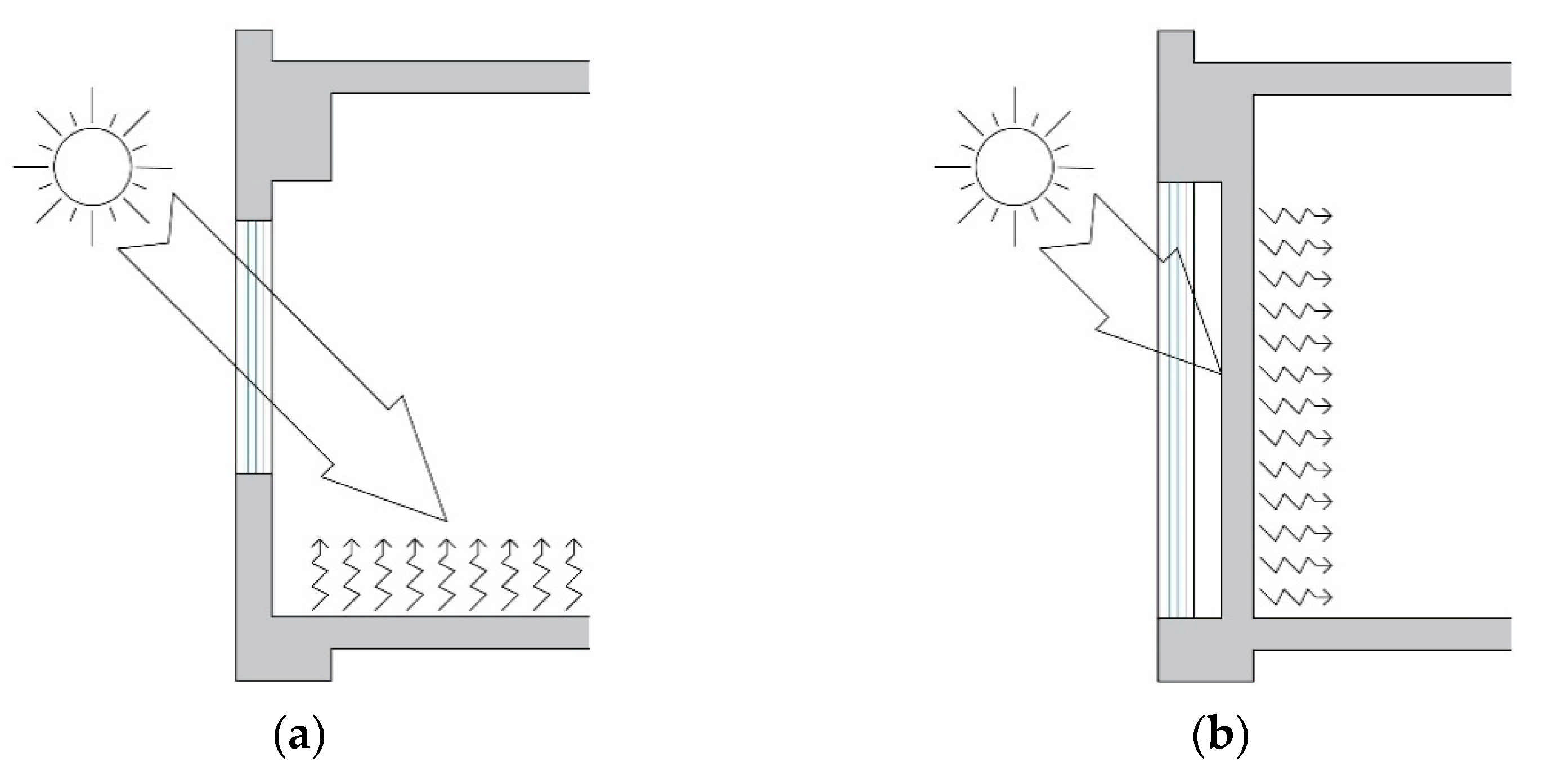
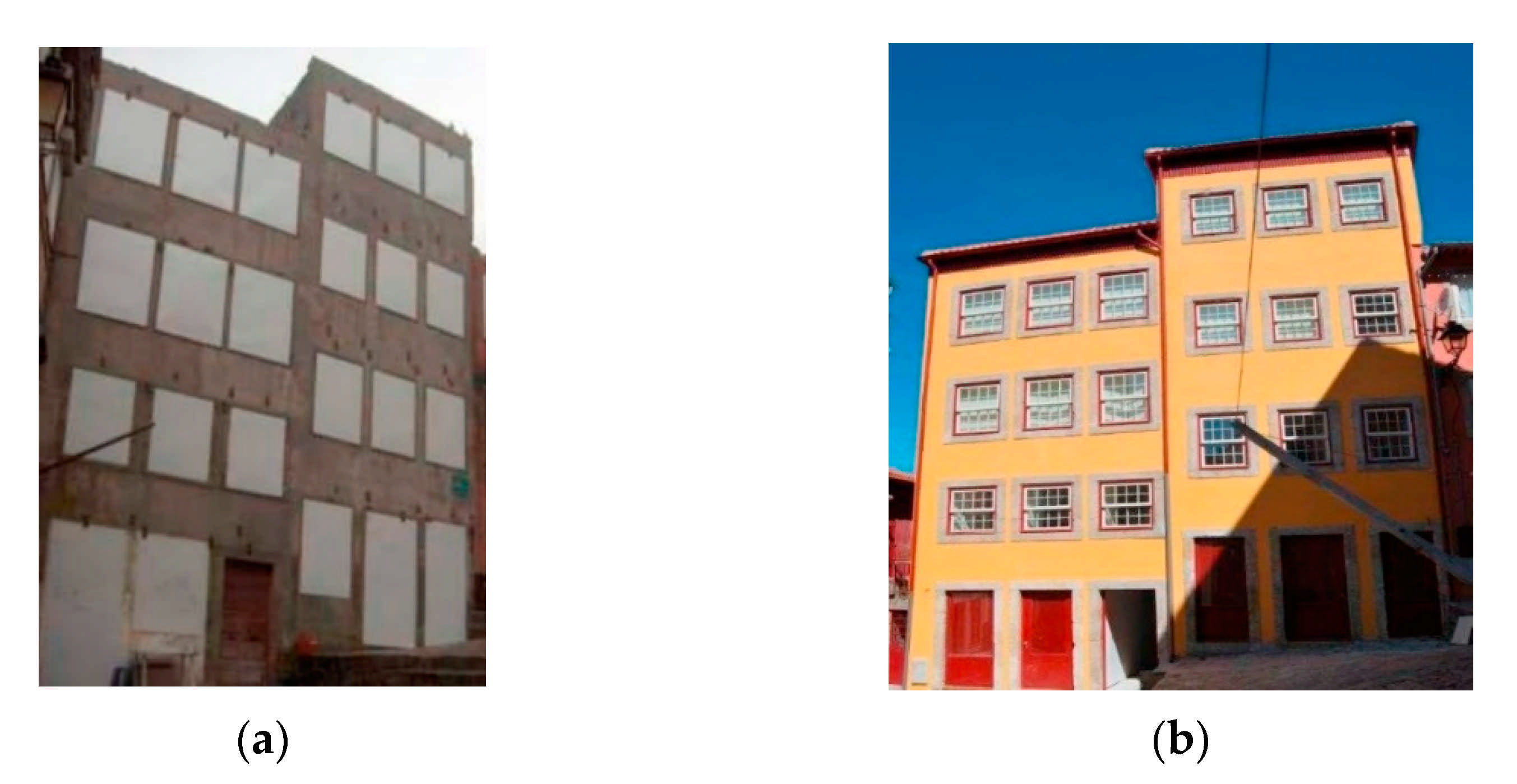
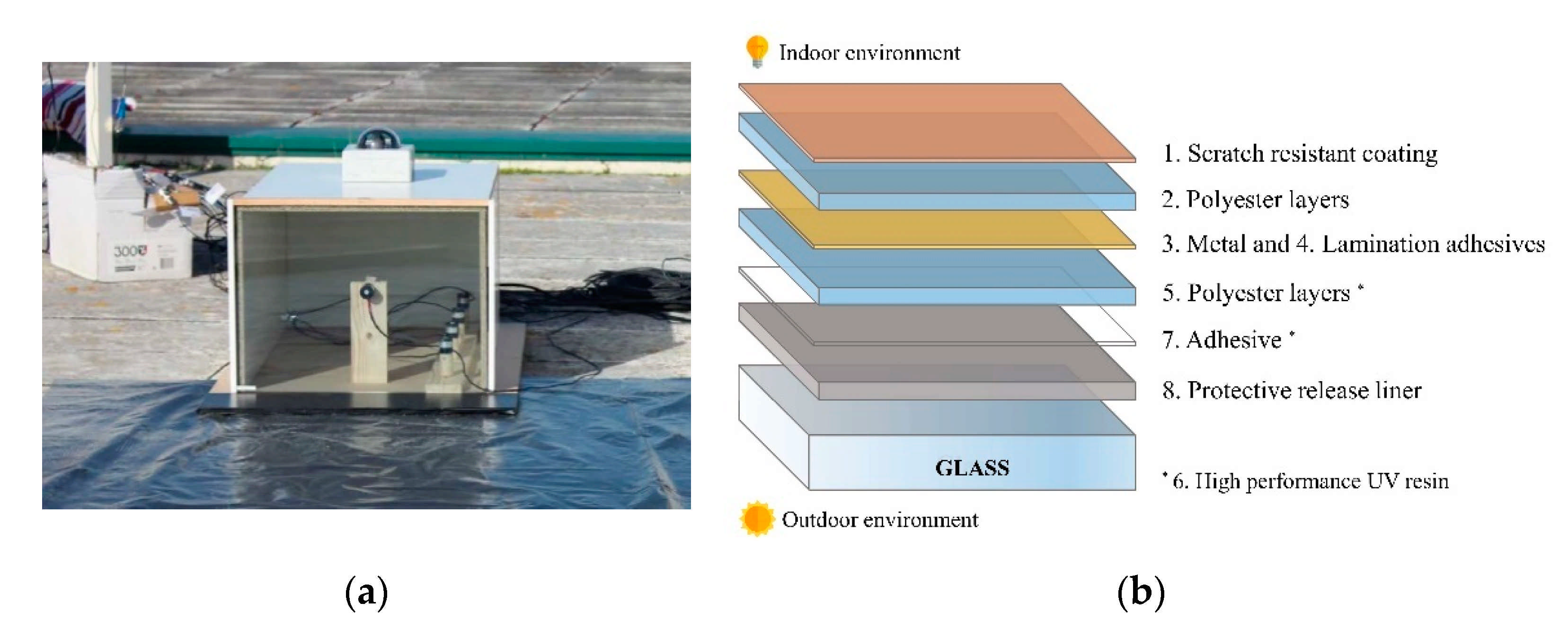

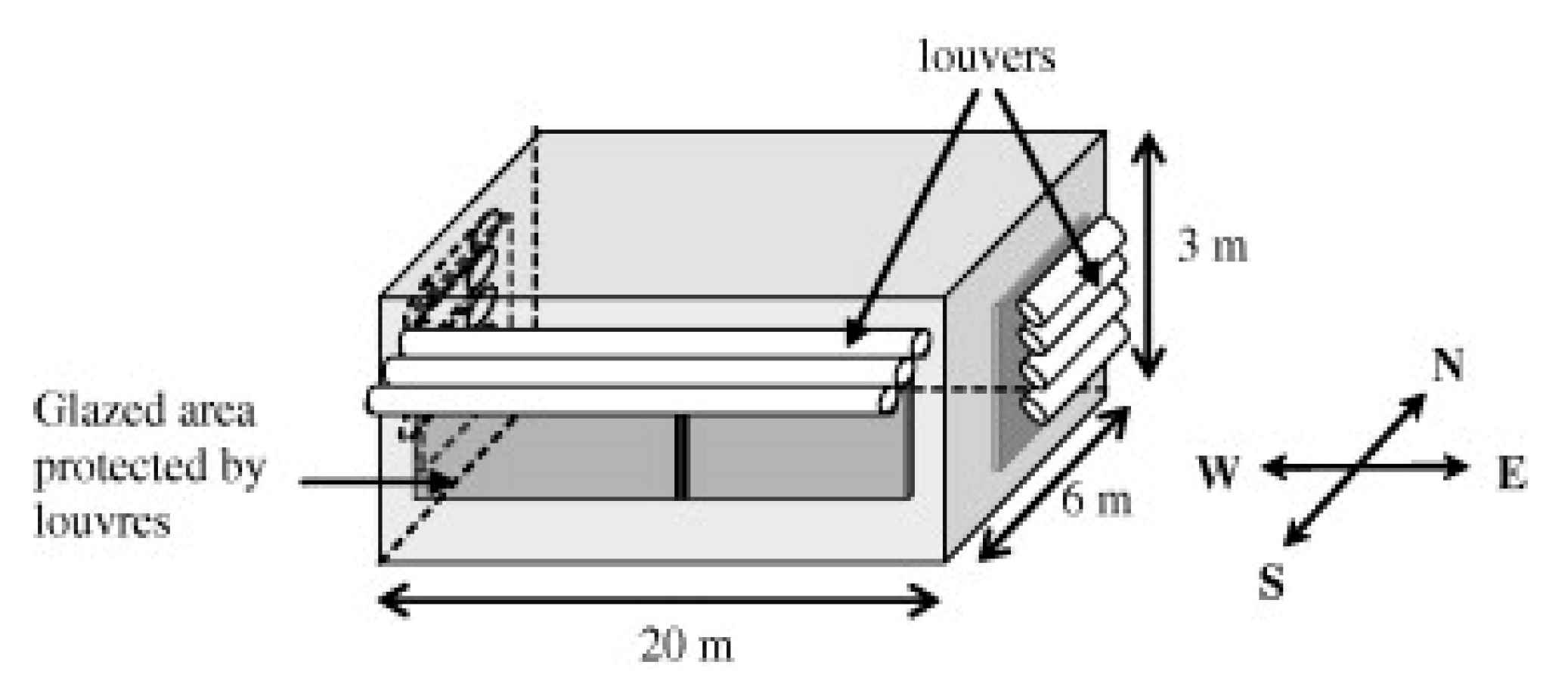
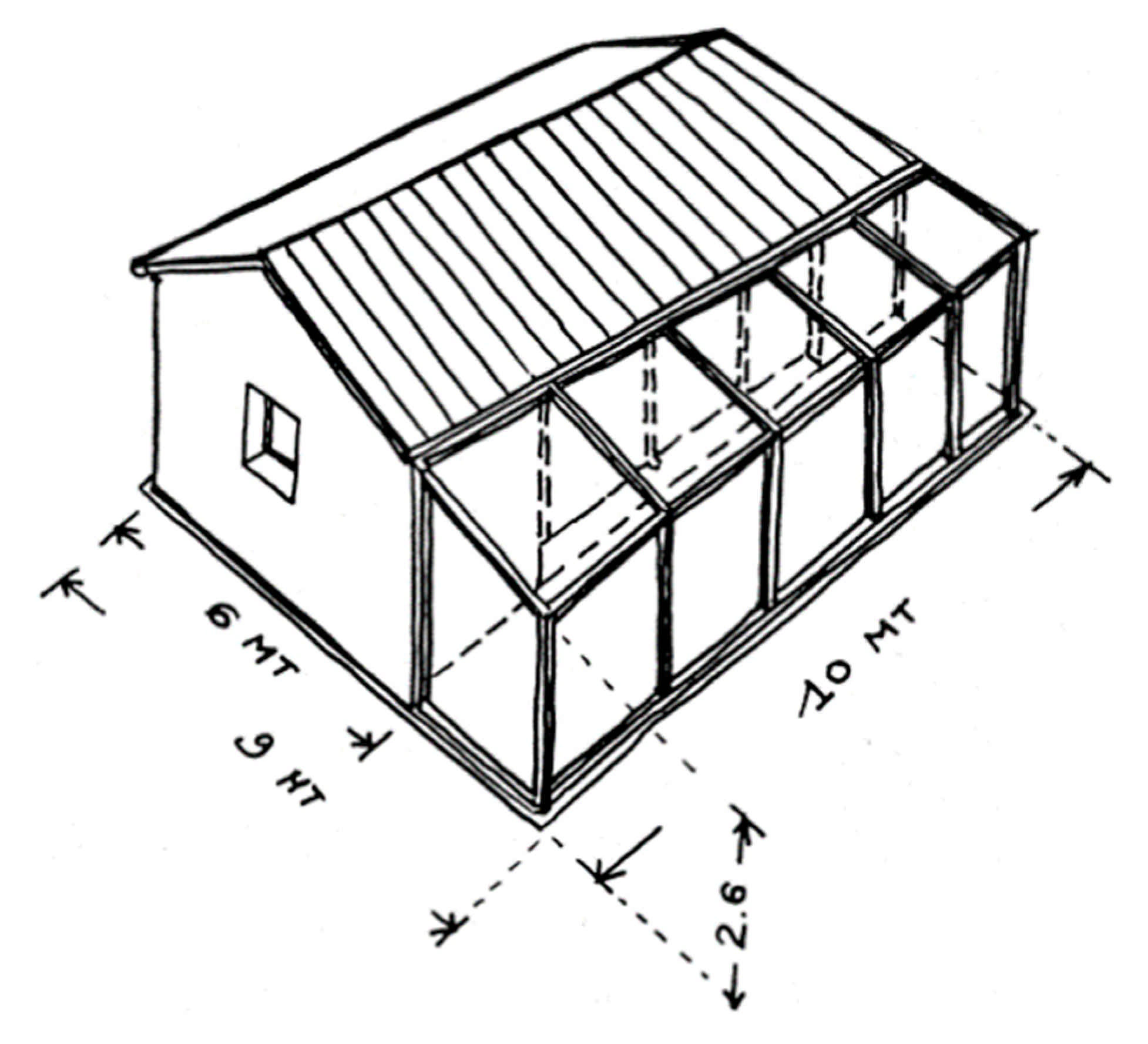
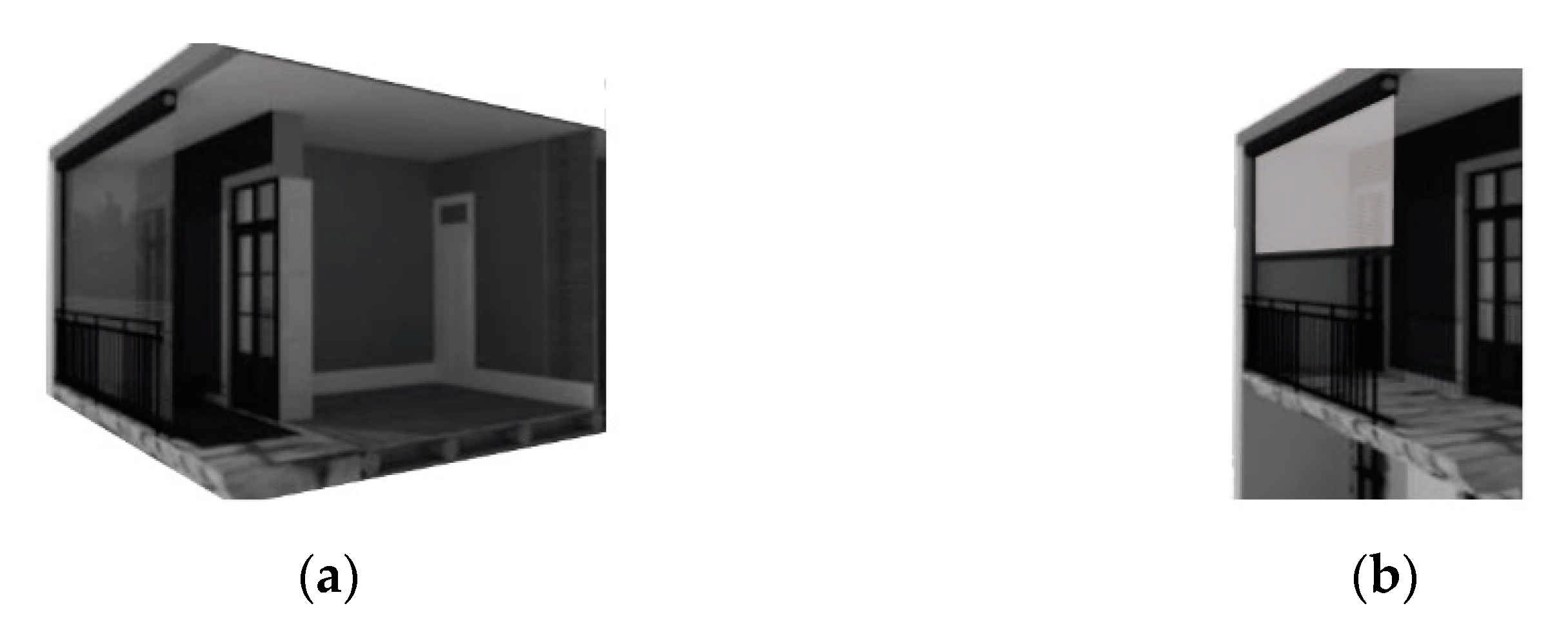
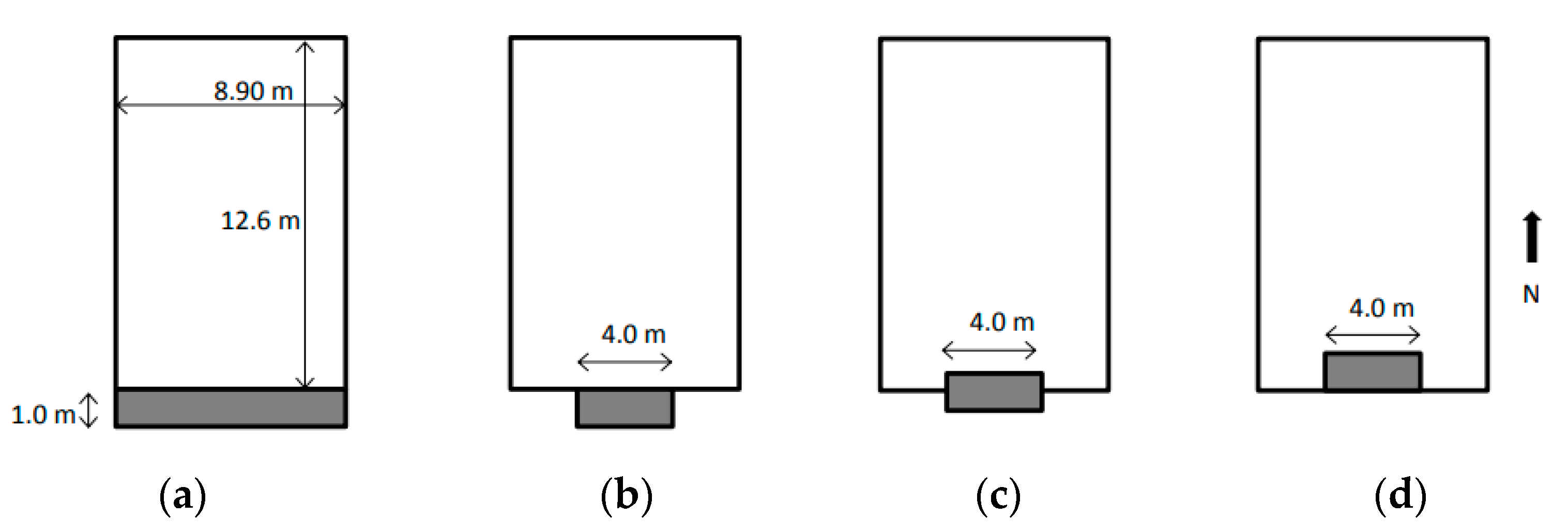

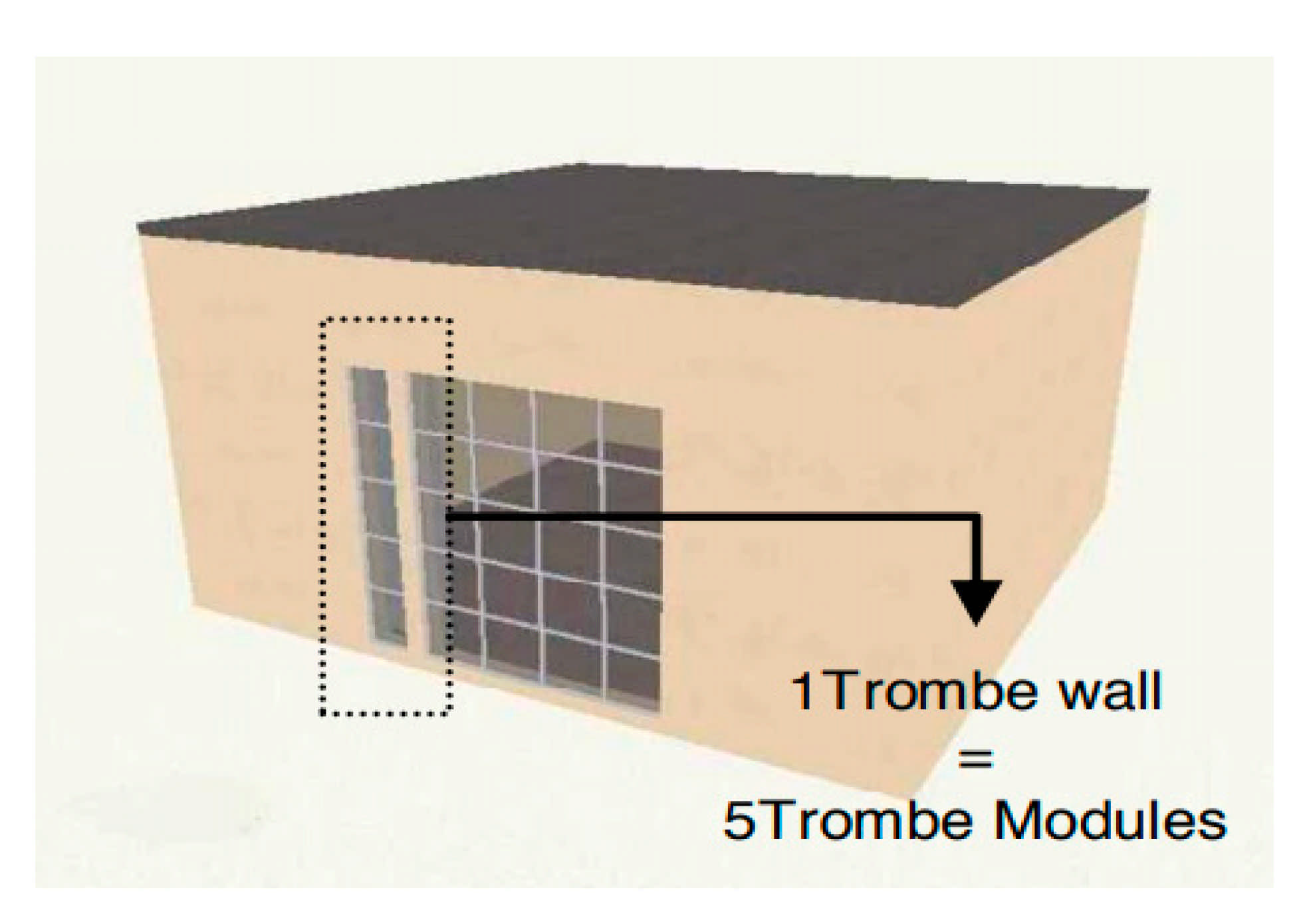
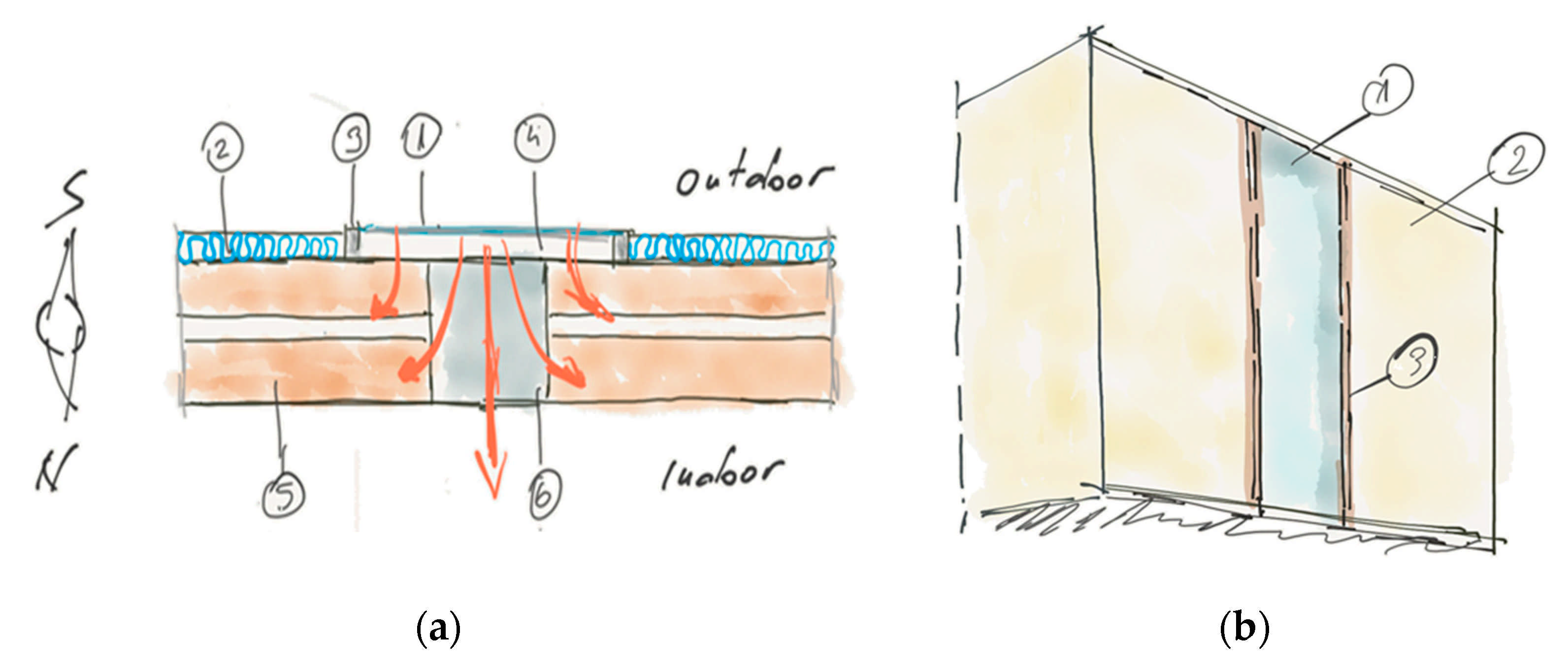
| Type of Solar Gain | Solar Technology | Targets | |
|---|---|---|---|
| Heating Season | Cooling Season | ||
| Direct | Glazing technologies | √ | √ |
| Sun shading technologies | √ | ||
| Indirect | Sunspace technologies | √ | |
| Trombe wall technologies | √ | ||
| Scope | Indicator | Unit |
|---|---|---|
| Solar availability | Solar irradiation on the façade surface | kWh/m2/year |
| Hours of solar exposure | Hours | |
| Thermal performance and comfort | Discomfort period | Hours; % |
| Heat gain | MJ/m2; kW/m2 | |
| Heat transmission (Heat flux) | W/m2 | |
| Predicted Mean Vote (PMV) | -- | |
| Relative humidity | % | |
| Temperature (surface: glazing and massive wall; cavity) | °C | |
| Time lag | Hours | |
| Indoor air quality and acoustics | CO2 concentration | ppm |
| Acoustics | −dB; RT60 | |
| Energy efficiency | Cooling energy needs (or cooling energy needs savings) | kWh; kWh/year; % |
| Energy storage (and release) | Hours | |
| Heating energy needs (or heating energy needs savings) | kWh; kWh/year; % | |
| Environment | CO2 emissions (production and operational phase) | kg CO2 eq. |
| Energy demand (production and operational phase) | kWh; kWh/m2 | |
| Economic | Annual savings | €; % |
| Internal rate of return (IRR) | -- | |
| Investment costs | € | |
| Net present value (NPV) | -- | |
| Payback period (PP) | Years | |
| Savings-to-investment ratio (SIR) | -- |
Publisher’s Note: MDPI stays neutral with regard to jurisdictional claims in published maps and institutional affiliations. |
© 2021 by the authors. Licensee MDPI, Basel, Switzerland. This article is an open access article distributed under the terms and conditions of the Creative Commons Attribution (CC BY) license (http://creativecommons.org/licenses/by/4.0/).
Share and Cite
Brito-Coimbra, S.; Aelenei, D.; Gloria Gomes, M.; Moret Rodrigues, A. Building Façade Retrofit with Solar Passive Technologies: A Literature Review. Energies 2021, 14, 1774. https://doi.org/10.3390/en14061774
Brito-Coimbra S, Aelenei D, Gloria Gomes M, Moret Rodrigues A. Building Façade Retrofit with Solar Passive Technologies: A Literature Review. Energies. 2021; 14(6):1774. https://doi.org/10.3390/en14061774
Chicago/Turabian StyleBrito-Coimbra, Sara, Daniel Aelenei, Maria Gloria Gomes, and Antonio Moret Rodrigues. 2021. "Building Façade Retrofit with Solar Passive Technologies: A Literature Review" Energies 14, no. 6: 1774. https://doi.org/10.3390/en14061774
APA StyleBrito-Coimbra, S., Aelenei, D., Gloria Gomes, M., & Moret Rodrigues, A. (2021). Building Façade Retrofit with Solar Passive Technologies: A Literature Review. Energies, 14(6), 1774. https://doi.org/10.3390/en14061774









